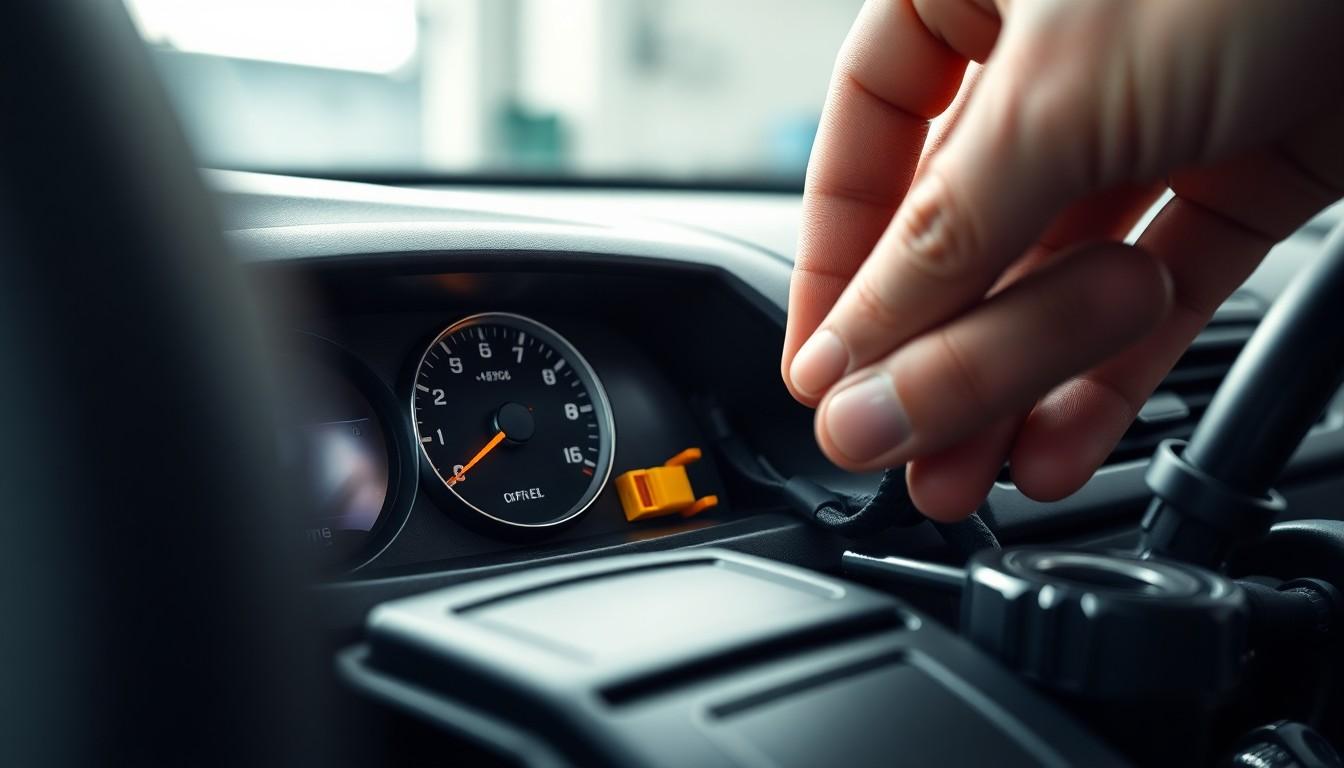Is your vehicle’s petrol meter acting up? We know how frustrating it can be when you can’t rely on something as essential as your fuel gauge. That uncertain feeling of whether you’ll make it to the next gas station isn’t just annoying—it’s potentially dangerous.
In this guide, we’ll explore the common causes behind malfunctioning fuel gauges and provide practical answers to get your meter back on track. From faulty sensors to electrical issues, we’ve researched the most frequent culprits that leave drivers guessing about their fuel levels. Our step-by-step troubleshooting tips will help you diagnose the problem before heading to a mechanic—potentially saving you time and money.
Common Causes of a Petrol Meter Not Working
When a fuel gauge fails to provide accurate readings, several underlying problems could be to blame. Our research shows that understanding these common causes can help you diagnose the issue before visiting a mechanic.
Faulty Fuel Sending Unit
The fuel sending unit serves as the primary component responsible for measuring fuel levels in your tank. Located inside the fuel tank, this device contains a float arm attached to a resistor that changes electrical resistance based on the fuel level. Over time, sending units deteriorate due to constant exposure to fuel, causing corrosion on contact points or mechanical wear on moving parts. Signs of a failing sender include erratic gauge readings, stuck indicators (either full or empty regardless of actual fuel level), or a gauge that fluctuates wildly during acceleration or turning. Replacing a faulty sending unit typically costs between $200-$500 depending on your vehicle make and model.
Damaged Wiring Connections
Electrical connectivity issues represent the second most common cause of fuel gauge malfunctions. The wiring between your fuel sending unit and instrument cluster passes through multiple connection points, each susceptible to damage. Corroded terminals, frayed wires, and loose connections often interrupt the electrical signal needed for accurate readings. These problems frequently occur in older vehicles or those exposed to moisture and road salt. Testing for wiring problems requires a multimeter to check for continuity and proper voltage readings at various points in the circuit. Professional electricians can trace and repair these issues for approximately $100-$300, depending on the complexity and accessibility of the affected areas.
Malfunctioning Instrument Cluster
Your vehicle’s instrument cluster houses the fuel gauge along with other important indicators. Electronic failures within this assembly often affect multiple gauges simultaneously rather than just the fuel indicator. Modern vehicles use complex circuit boards and microprocessors within their instrument panels, making them vulnerable to electronic glitches, solder joint failures, and component burnout. Temperature fluctuations, voltage spikes, and normal aging all contribute to instrument cluster failures. Diagnostic trouble codes (DTCs) stored in your vehicle’s computer system frequently point to exact instrument panel problems when scanned with appropriate equipment. Complete instrument cluster replacement ranges from $400-$1,200 for parts and labor, though some specialized repair services can rebuild existing clusters for about half that cost.
How to Diagnose a Non-Working Fuel Gauge

Diagnosing a non-working fuel gauge requires a systematic approach to identify the root cause. We’ve compiled essential diagnostic steps to help you pinpoint electrical issues and sending unit problems effectively.
Checking for Electrical Issues
Electrical problems often cause fuel gauge malfunctions and can be diagnosed with basic tools. Start by checking the voltage at both the gauge and sender unit using a multimeter—readings should show approximately 12 volts for proper operation. Inspect the fuel gauge fuse in your vehicle’s fuse box, as a blown fuse completely prevents gauge operation. Examine all wiring and connections between the tank sender unit and dashboard gauge, looking for corrosion, breaks, or damage that might interrupt signal transmission. Verify ground connections at both the gauge and sender unit are secure with good continuity, since poor grounding commonly causes gauge failures.
Testing the Fuel Sending Unit
The fuel sending unit’s condition directly affects gauge accuracy and can be evaluated through several methods. Different reading patterns indicate exact problems—a gauge stuck on empty might result from a float separated from its arm or corroded wires, while a constant full reading suggests a faulty resistor or shorted wiring. Fluctuating readings between empty and full typically point to mechanical failures in the float arm mechanism. Perform a visual inspection of the sending unit to check for wear, mechanical failures, or a sticking float arm. Test the sending unit’s functionality by simulating different fuel levels and observing gauge response. Measure resistance across sender terminals with a multimeter and compare readings to manufacturer specifications in your vehicle manual. For modern vehicles, connect an OBD-II scanner to check for error codes related to the fuel system, providing additional diagnostic information.
DIY Fixes for Petrol Meter Problems

Several DIY fixes can resolve petrol meter issues without requiring professional help. These answers address common problems like blown fuses, wiring issues, and faulty sender units that typically cause fuel gauge malfunctions.
Blown or Worn Fuse
Fuses protect your vehicle’s electrical components from damage. Locate the fuse box in your vehicle (usually under the dashboard or in the engine compartment) and check the fuse linked to the fuel gauge system. If you find the fuse is blown or worn, simply replace it with a new one of the correct amperage to potentially restore gauge functionality.
Improper Wiring or Ground
Electrical connections often deteriorate over time. Inspect all wiring and ground connections related to the fuel gauge for breaks, corrosion, or loose connections. Clean any corroded terminals using a wire brush and reconnect any loose wires. Pay special attention to areas where wires pass through plastic components, as these spots commonly develop burnt or damaged sections that interrupt the signal flow.
Broken or Corroded Sender Unit
The fuel sending unit transmits fuel level information to your dashboard gauge. To check and repair this component:
- Access the sender unit by flipping up the rear bench seat and removing carpet covering the access panel
- Disconnect the electrical connections and remove the rubber seal
- Unscrew the panel to expose the sending unit
- Carefully extract the unit to examine the float arm for damage
- Clean any varnish or rust using sandpaper and carburetor cleaner
- Test the unit with a multimeter – resistance should change smoothly as you move the float arm (typically 0 ohms when empty to 30-60 ohms when full)
- Reinstall the cleaned and functional sender unit
Temporary Workarounds
Dealing with a non-functional fuel gauge doesn’t mean you’re stranded without options. Manual fuel level checks provide the most reliable alternative—simply use a clean dipstick or wooden dowel to measure fuel depth in your tank regularly. Tracking your mileage offers another practical approach—reset your trip odometer after each fill-up and calculate remaining range based on your vehicle’s known fuel economy. Many drivers also adopt the cautious strategy of refilling at half-tank to maintain a comfortable buffer against unexpectedly running empty.
When to Attempt Repairs Yourself
DIY fuel gauge repairs make sense in exact situations. Basic electrical issues like blown fuses or corroded connections represent low-hanging fruit for home mechanics with minimal tools and knowledge requirements. Access to a multimeter and basic hand tools qualifies you for most sender unit repairs, especially on older vehicles with simpler systems. Cost considerations also factor in—replacing a $10 fuse or cleaning connections yourself saves important money compared to professional diagnosis fees starting at $80-100. But, modern vehicles with integrated electronic clusters or complex fuel delivery systems often require specialized diagnostic equipment and expertise, making professional service the wiser choice in these cases.
Professional Repair Options and Costs

When your petrol meter stops working, professional repair options vary in cost and service quality depending on where you take your vehicle. Understanding these differences helps you make an well-informed choice about the best repair approach for your exact situation and budget constraints.
Dealership vs. Independent Mechanic
Dealerships offer specialized expertise with manufacturer-trained technicians who know your vehicle’s exact systems inside and out. They use genuine OEM parts that ensure perfect compatibility with your vehicle’s fuel gauge system. Warranty coverage is a important advantage of dealership repairs, as your fuel gauge repair might be covered if your vehicle is still under manufacturer warranty. Independent mechanics typically charge 15-30% less for labor rates compared to dealerships, making them more budget-friendly. They often use aftermarket parts that cost less than OEM components while still providing reliable performance. Many independent shops offer personalized service with more flexibility in scheduling and repair approaches, though quality can vary between different establishments.
Average Repair Expenses
Repair costs for fuel gauge issues depend largely on the exact component that needs fixing. Fuse replacements represent the simplest and most affordable repair, typically costing $10-$30 including basic labor. Wiring and connection repairs range from $50-$200 depending on accessibility and complexity of the electrical issue. Fuel sending unit replacement constitutes one of the most common major repairs, costing between $200-$500 including parts and labor, with prices varying based on vehicle make and model. Instrument cluster replacements represent the most expensive option at $500-$1,500, necessary when the gauge itself has failed rather than the sending unit or wiring. Diagnostic fees add $50-$150 to your total bill regardless of which repair option you choose, as technicians must first determine the exact cause of the non-functioning fuel gauge.
| Repair Type | Average Cost Range | Notes |
|---|---|---|
| Fuse Replacement | $10-$30 | Simplest repair, minimal labor |
| Wiring Repairs | $50-$200 | Varies by damage extent |
| Fuel Sending Unit | $200-$500 | Most common major repair |
| Instrument Cluster | $500-$1,500 | Most expensive option |
| Diagnostic Fee | $50-$150 | Additional to repair costs |
Driving Safely with a Broken Fuel Gauge

A non-functioning fuel gauge creates important safety risks for drivers, potentially leaving you stranded when your vehicle unexpectedly runs out of fuel. This issue often stems from problems with the fuel sending unit, faulty wiring, or poor ground connections rather than the gauge itself.
Tracking Mileage Manually
Manual mileage tracking offers a reliable method to monitor your fuel levels when your gauge fails. Start by recording your odometer reading each time you fill your tank completely, noting how many miles you can typically drive on a full tank based on your vehicle’s fuel efficiency. Simple calculations will help determine when you’ll need to refuel—for example, if your car averages 300 miles per tank, plan to refill around 250 miles to maintain a safety margin. Many drivers keep a small notebook in their glove compartment specifically for tracking these fill-ups and mileage points, though this approach requires consistent documentation to be effective.
Using Smartphone Apps as Alternatives
Smartphone apps provide modern answers for managing a broken fuel gauge, though they can’t directly measure your fuel level. Fuel logging applications like Fuelio, GasBuddy, and Drivvo enable you to record each refueling stop, track your fuel economy, and receive notifications when you’re approaching your typical refueling mileage. Some advanced vehicle tracking apps can integrate with OBD-II devices to access limited vehicle data, potentially offering more accurate consumption estimates. These digital tools eliminate the need for paper logs while providing helpful analytics about your driving patterns and fuel consumption, but they still rely on your consistent input after each fill-up to function properly.
Before relying exclusively on these alternatives, thorough troubleshooting might solve your gauge problems entirely. Check your vehicle’s fuses using a multimeter to verify proper voltage, inspect wiring connections for corrosion or damage, and test the fuel sending unit’s resistance values. Addressing these common issues often restores gauge functionality without requiring extensive tracking systems or app-based workarounds.
Conclusion
A faulty petrol meter can be more than just an annoyance—it’s a potential safety hazard that requires prompt attention. By understanding the common causes and following our troubleshooting steps you can often identify the issue without immediately heading to a mechanic.
Whether you opt for DIY repairs or professional service depends on your comfort level with vehicle maintenance and the complexity of the problem. Until you get it fixed keep track of your mileage manually or use smartphone apps to avoid getting stranded.
Remember that addressing fuel gauge problems early typically results in simpler less expensive repairs. Don’t ignore this important dashboard component as it’s your primary window into your vehicle’s fuel status.
Frequently Asked Questions
What are the most common causes of a fuel gauge not working?
The most common causes include a faulty fuel sending unit, damaged wiring connections, and malfunctioning instrument clusters. The sending unit, which measures fuel levels, can deteriorate over time leading to erratic readings. Electrical issues, particularly in older vehicles, can interrupt signals between components. Instrument cluster failures might affect multiple gauges simultaneously and typically require professional diagnosis.
How can I diagnose a broken fuel gauge myself?
Start by checking electrical components with a multimeter to test voltage at the gauge and inspect fuses. Examine wiring for damage or corrosion, particularly ground connections. Test the fuel sending unit by measuring resistance at different fuel levels—inconsistent readings suggest a problem. For modern vehicles, an OBD-II scanner can identify error codes related to the fuel system or instrument cluster.
What are some DIY fixes for fuel gauge problems?
Simple DIY fixes include replacing blown fuses, repairing damaged wiring, cleaning corroded connections, and checking ground connections. If accessible, you can inspect the fuel sending unit for damage or a stuck float. For temporary solutions, track your mileage between fill-ups and use the trip odometer to estimate fuel consumption until proper repairs can be made.
When should I seek professional help for my fuel gauge issues?
Seek professional help if you’ve checked basic electrical components and still have problems, if your vehicle has complex electronic systems, or if accessing the fuel tank or sending unit requires specialized tools. Also, consult a professional if you’re uncomfortable working with electrical systems or if diagnostic trouble codes indicate more serious issues that require expert interpretation.
How much does it cost to fix a fuel gauge?
Repair costs vary significantly based on the issue and your vehicle model. Fuse replacements are inexpensive ($10-20), while wiring repairs typically cost $50-150. Fuel sending unit replacements range from $200-500, including labor. Complete instrument cluster repairs can run $200-800. Diagnostic fees ($75-150) may apply before repairs begin. Independent mechanics generally charge less than dealerships.
Is it dangerous to drive with a broken fuel gauge?
Yes, driving with a malfunctioning fuel gauge is risky as you may run out of fuel unexpectedly, potentially leaving you stranded in unsafe locations or causing engine damage from running on empty. Without reliable fuel level information, you’re essentially driving blind regarding your vehicle’s range, which can be particularly dangerous during long trips or in remote areas.
How can I track my fuel if my gauge isn’t working?
Track your mileage between fill-ups by recording odometer readings and calculating when to refuel based on your vehicle’s known fuel efficiency. Reset your trip odometer after each complete fill-up and refuel at consistent intervals. Alternatively, use smartphone apps designed for fuel tracking that can log refueling stops and calculate your vehicle’s range based on historical consumption patterns.
Do smartphone apps really help with tracking fuel levels?
Yes, fuel-tracking apps can be effective alternatives when your gauge isn’t working. These apps allow you to log fill-ups, track fuel economy, and estimate remaining range based on your driving patterns. However, they require consistent input of accurate information to be reliable and won’t provide real-time fuel level data like a functioning gauge would. They’re best used as temporary solutions while arranging repairs.

